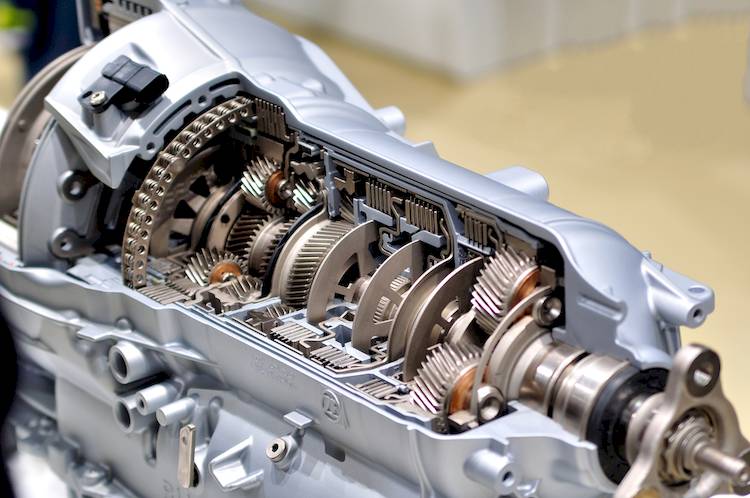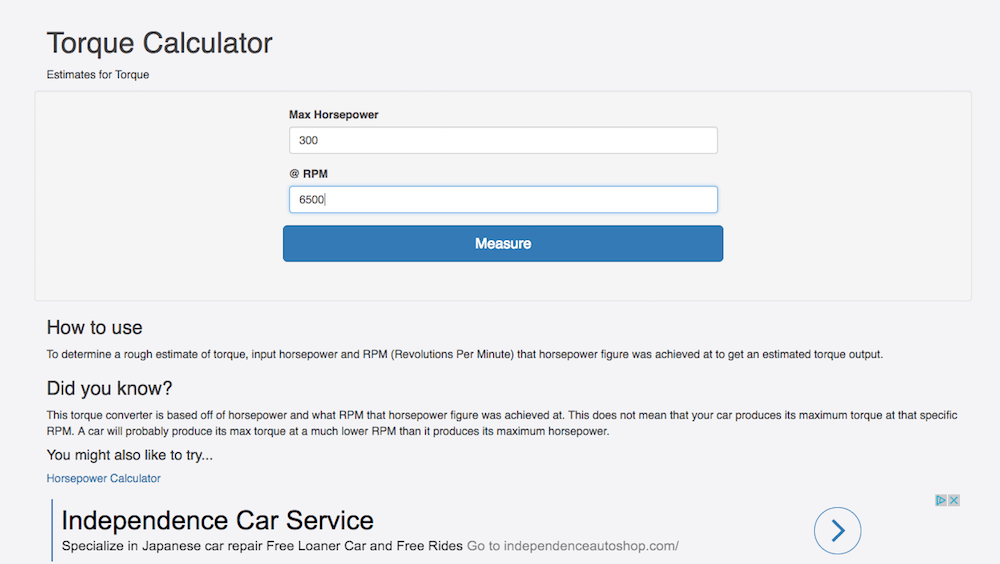

Whether you're buying a new car or building a hot rod in your garage, two factors come into play when determining engine performance: horsepower and torque. If you're like most DIY mechanics or automotive enthusiasts, you probably have a good understanding of the relationship between horsepower and torque, but may struggle on comprehending how those "foot pound" numbers are achieved. Believe it or not, it's really not that complex.
Before we get too technical, let's break down some simple facts and definitions that make it easier to comprehend why both horsepower and torque are important factors to consider. We should begin by defining the three elements of measuring performance of a combustion engine: speed, torque and horsepower.
Part 1 of 4: Understanding how engine speed, torque, and horsepower impact overall performance
In a recent Hot Rod magazine article, one of the greatest mysteries in engine performance was finally figured out by getting back to basics of how horsepower is actually factored. Most people assume that dynometers (engine dynos) are designed to measure the horsepower of an engine.
In reality, dynometers do not measure horsepower, they measure torque. That torque figure is multiplied by the RPM it is measured at and then divided by 5,252 to produce a horsepower figure.
For more than 50 years, the dynometers used to measure torque and engine RPM simply couldn't handle the intense power produced by these engines. In fact, one cylinder on these 500 cubic inch displacement, nitromethane burning Hemis produces an estimated 800 pounds of thrust through a single exhaust pipe.
All engines, whether combustion or electrically powered, operate at different speeds. For the most part, the faster an engine completes its power stroke or cycle, the more power it produces. In regards to a combustion engine, the three elements that impact the overall performance of that engine are speed, torque and horsepower.
Speed is defined as how fast the motor performs its work. When we apply the speed of the engine to a number or a unit of measurement, we gauge the engine's speed in revolutions per minute or RPM. The "work" that the engine performs is a force applied over a measured distance. Torque is defined as a special type of work that produces rotation. This occurs when a force acts on a radius (or, for a combustion engine, the flywheel) and is typically measured in foot pounds.
Horsepower is the rate at which work is accomplished. Back in the old days, if objects needed to be moved, humans typically used a horse to move it. It was estimated that one horse could move approximately 33,000 foot pounds per minute. This is where the term "horsepower" originates. Different from speed, and torque, horsepower can be measured in multiple units including: 1 HP = 746 Watts, 1 HP = 2,545 BTUs, and 1 HP = 1,055 joules.
These three elements work together to produce engine power. As torque remains constant, speed and horsepower remain proportional. However, as the engine's speed increases, the horsepower also increases in order to maintain constant torque. Where many people get confused, however, is in how torque and horsepower impact the engine's speed. Quite simply, as the torque and horsepower increase, so does the engine's speed. The reverse is also true: when the torque and horsepower decrease, so does the engine’s speed.
Part 2 of 4: How engines are built to maximize torque
The modern combustion engine can be altered to enhance horsepower or torque by manipulating the size or length of the connecting rod and increasing the bore or diameter of the cylinder. This is often referred to as the bore/stroke ratio.
Torque is measured in Newton meters. In simple terms, this means that torque is measured in a 360-degree circular motion. Our example takes two identical motors that have the same sized bore (or the diameter of the combustion cylinder). However, one of the two motors has a longer "stroke" (or the depth of the cylinder as produced by a longer connecting rod). The motor with the longer stroke has more straight motion while it rotates through the combustion chamber and has more leverage to accomplish the same task.
Torque is measured in pound-feet or how much "twisting force" is applied to complete a task. For example, imagine you're trying to loosen a rusty bolt. Let's assume you have two different pipe wrenches, one is 2' long, the other is 1' long. Assuming you apply the same amount of force (in this case 50 pounds of pressure) you are actually applying 100 foot pounds of torque for the two foot wrench (50 x 2) and only 50 lbs. of torque (1 x 50) with the one foot wrench. Which wrench will help you loosen the bolt easier? The answer is easy – the one with more torque.
Engineers develop an engine to produce a higher torque to horsepower ratio for vehicles that need the extra “power” for acceleration or for climbing. Typically, you see higher torque ratings for heavy duty trucks used for towing applications or high performance engines where acceleration is critical (such as the NHRA Top Fuel Engine example noted above).
This is why automotive manufacturers often highlight the high torque potential of engines in truck commercials. Engine torque can also be amplified by changing ignition timing, adjusting air to fuel mixtures, and even manipulated to increase torque output during certain scenarios.
Part 3 of 4: Understanding other variables that impact overall torque rating of an engine
When it comes to measuring the torque, there are three unique variables within the combustion engine that you must consider:
The force created at a specific RPM: This is the max horsepower of the engine produced at a desired RPM. When an engine accelerates, there is an RPM or horsepower curve. As the engine RPM increases, the horsepower increases as well, until it reaches a maximum level.
The distance: This is the length of the connecting rod stroke: the longer the stroke, the more torque is created as we explained above.
The constant of the torque: This is a mathematical number that is assigned to all engines, 5252 or the constant RPM where the horsepower and torque are balanced. The number 5252 was derived from the observation that one horsepower was equivalent to 150 pounds which covered 220 feet in one minute. To express this in foot pounds of torque, a mathematical formula was introduced by James Watt, who invented the first steam engine.
The formula is as follows:
Assuming the force of 150 pounds is applied to one foot of a radius (or circle that's found inside a combustion engine's cylinder, for example) you'd have to convert this to foot pounds of torque.
220 feet in one minute needs to be extrapolated into revolutions per minute. To do this, you'd take two times Pi (or 3.141593) which equals 6.283186 feet. Take 220 feet and divide by 6.28 and we get an RPM of 35.014 for each revolution.
Take the 150 feet and multiply times 35.014 and you get 5252.1 – which is our constant that is factored into measuring foot pounds of torque.
Part 4 of 4: How to calculate the torque of a vehicle
The formula for figuring out torque is torque = horsepower of the engine x 5252, which is then divided by the RPMs.
The problem with torque, however, is that it is measured in two different places: directly from the engine and to the drive wheels. Other mechanical components than can increase or decrease torque ratings to the wheels include: flywheel size, transmission gear ratios, drive axle gear ratios, and tire/wheel circumference.
In order to figure out the torque to the wheel, all of these items must be factored into the equation, which is best left to a computerized program included in a performance dyno. On this type of equipment, the car is placed on a rack and the drive tires are placed next to a series of rollers. The engine is plugged into a computer read out that monitors engine RPM, fuel curve, and gear ratios. These numbers are factored with wheel speed, acceleration and shift RPM's as the vehicle is driven on the dyno for a desired length of time.
The calculation of torque of the engine is a lot easier to determine. Following the formula above, it's clear to see how the torque of the engine is proportional to the horsepower and the engines' RPM as explained in the first section. By using this formula, you can figure out the torque and horsepower ratings at each point of the RPM curve. You need to have the engine's horsepower figures which are produced by the engine manufacturer in order to calculate the torque.

Some people utilize an online calculator, offered by MeasureSpeed.com that requires you input the engine's max horsepower ratings (supplied by the manufacturer or completed during a professional engine dyno pull) and the desired RPM.
If you notice that your engine performance struggles to accelerate and does not have the power you think it should, have one of YourMechanic’s certified mechanics perform an inspection to determine the source of the issue.



